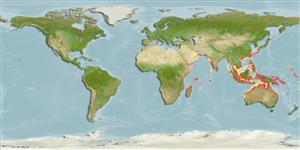Environment: milieu / climate zone / depth range / distribution range
البيئة
بحري; المياه العذبة; مياه مخلوطة القاع; مهاجرة بين الياه الملحه و الحلوة لكن ليس للتزاوج (Ref. 46888). Tropical
Indo-Pacific: Delagoa Bay, Mozambique and Madagascar to China and Philippines (Ref. 6802, 82489). Eastern Atlantic: collected from Port Harcourt (Niger delta in Nigeria) (Ref. 7391, 57413), apparently introduced (Ref. 7050). Also found (introduced) in Guinea and Cameroon (Ref. 82489). Other introduced populations are known from Panama, Venezuela and Brazil (Ref. 82489).
الحجم / وزن / العمر
Maturity: Lm ? range ? - ? cm
Max length : 10.7 cm TL ذكر/ مختلط الجنس; (Ref. 57413)
الأشواك الظهرية (المجموع): 7; الأشعة الظهرية الناعمة (المجموع): 7-8; شوكة شرجية 1; أشعه شرجية لينه: 7 - 9. Diagnosis: 11-15 scales in predorsal series; 25-29 ctenoid scales in longitudinal series (including 1-2 scales on caudal fin base); 9-12 scales in rearward transverse series; 1st dorsal fin: VI; second dorsal fin: I,8 (rarely 7); anal fin: I,7-9 (usually 8); pectoral fins: 19-22; pelvics relatively long, their tips almost, or just reaching level of anus; caudal fin rounded, with 11-16 segmented rays (Ref. 57413, 82489). 1st gill arch with 4-5 gill rakers on epibranchial, 6-8 on ceratobranchial (Ref. 82489), about 12 in total, that are narrow and spine-like (Ref. 57413). Dark brown, scales edged in dark brown (Ref. 5493). Body with 4-5 oblique bands (Ref. 5493, 82489), crossing dorsum at nape, 1st dorsal fin, 2nd dorsal fin and caudal peduncle (one or two)(Ref. 82489). Anterior part of 1st dorsal fin dark, 2nd dorsal and caudal fin with alternating dark brown and white spots, anal and pelvic fins dusky to black, pectorals clear; females with more distinct bands and lighter fins (Ref. 5493).
Coloration: Preserved specimens: 2-3 longitudinal series of small dark spots above midline of flanks; broad, dark, crossbar running from each dorsal fin base towards belly, bifurcating on flanks into separate bands; 2 narrower crossbars on caudal peduncle; a lunate band on base of caudal fin; dark pre- and suborbital bands on head, confluent below eye; dark spot behind eye and light horizontal band running to posterior of operculum; snout marbled; 3 dark crossbars on nape preceding a light area in front of 1st dorsal-fin base; ventral area of head speckled; both dorsal fins with a dark proximal band; 1st dorsal fin more or less entirely dark to distal margin; 2nd dorsal fin with dark distal margin; anal and pelvic fins black, except distal area of pelvic fins lighter; pectoral fins with a dark spot at base (edged red in life) and an upper, smaller, dark spot sometimes evident (Ref. 57413).
Inhabits rivers, estuaries (Ref. 4967) and mangrove creeks (Ref. 10812). Feeds on crustaceans and small fishes. Marketed fresh (Ref. 12693). Maximum size recorded in West Africa was 8.3 cm TL (Ref. 57413).
Life cycle and mating behavior
النضج | التكاثر | وضع البيض | بيض | الخصوبة | Larvae
Distinct pairing (Ref. 205).
Miller, P.J. and P. Wongrat, 1990. Eleotridae. p. 952-957. In J. C. Quéro, J. C. Hureau, C. Karrer, A. Post and L. Saldanha (eds.) Check-list of the fishes of the eastern tropical Atlantic (CLOFETA). JNICT, Lisbon; SEI, Paris; and UNESCO, Paris. Vol. 2. (Ref. 10812)
IUCN Red List Status (Ref. 130435)
استخدامات بشرية
مصائد:
مزيد من المعلومات
مراجعالأستزراع المائيملف الأستزراع المائيسلالاتجينيElectrophoresesالتوريثالأمراضمعالجةNutrientsMass conversion
المتعاونينصورStamps, Coins Misc.اصواتالتسمم باكل السمكسرعةنوع السباحةمنطقة الخياشيمعظمة الأذندماغرؤية
أدوات
تقارير خاصة
Download XML
مصادر علي الأنترنت
Estimates based on models
Preferred temperature (Ref.
123201): 24.8 - 29.1, mean 28.3 °C (based on 1224 cells).
Phylogenetic diversity index (Ref.
82804): PD
50 = 0.5156 [Uniqueness, from 0.5 = low to 2.0 = high].
Bayesian length-weight: a=0.01230 (0.00622 - 0.02432), b=3.12 (2.94 - 3.30), in cm total length, based on LWR estimates for this species & (Sub)family-body (Ref.
93245).
مستوى غذائي (Ref.
69278): 4.0 ±0.66 se; based on food items.
المرونه (Ref.
120179): عالي, الحد الزمني الأدني لتضاعف عدد أفراد المجتمع أقل من 15 شهر (Preliminary K or Fecundity.).
Fishing Vulnerability (Ref.
59153): Low vulnerability (10 of 100).
